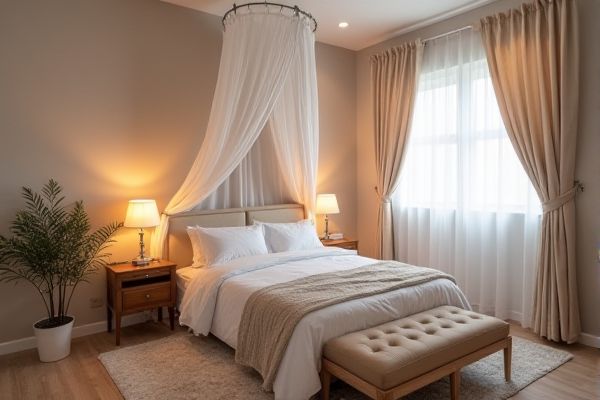
A bed canopy offers an elegant, open design that enhances bedroom aesthetics and provides gentle protection from insects, while a bed tent creates a fully enclosed space ideal for privacy and cozy comfort, especially in shared rooms or for children. Discover which option best suits Your needs and preferences by exploring the detailed comparison in this article.
Table of Comparison
| Feature | Bed Canopy | Bed Tent |
|---|---|---|
| Purpose | Decorative, provides mosquito protection and privacy | Enclosed sleeping space for privacy and insect protection |
| Material | Lightweight fabric like mesh or voile | Durable nylon or polyester with mesh windows |
| Structure | Hangs from ceiling or bed frame, open sides | Freestanding or attaches to bed frame, fully enclosed |
| Setup | Simple hanging installation | Pop-up or frame assembly required |
| Portability | Lightweight but less compact | Compact, easy to carry and move |
| Ventilation | Excellent airflow due to open design | Good ventilation via mesh panels |
| Privacy | Moderate, visible inside | High, fully enclosed space |
| Use Case | Indoor bedrooms, decorative and light protection | Camping, shared rooms, or allergy control |
Introduction to Bed Canopies and Bed Tents
Bed canopies and bed tents offer distinct solutions for enhancing bedroom comfort and privacy, with bed canopies typically consisting of fabric draped over a frame to create an elegant, airy enclosure. Bed tents are enclosed structures made from mesh or fabric, designed to provide a private, insect-free sleeping environment, particularly popular for children and outdoor use. Both options improve sleep quality by reducing light exposure and distractions while serving different aesthetic and functional preferences.
Key Differences Between Bed Canopies and Bed Tents
Bed canopies are lightweight fabric drapes that hang from a frame or ceiling, providing an elegant decorative touch and minimal insect protection. Bed tents are enclosed structures made of mesh or fabric with zippered openings, offering complete privacy, noise reduction, and insect shielding. The primary difference lies in bed tents' fully enclosed design versus bed canopies' open, airy coverage.
Design and Aesthetic Considerations
Bed canopies often feature elegant, flowing fabrics and open designs that enhance bedroom aesthetics with a romantic or luxurious vibe. Bed tents prioritize functionality with enclosed, mesh-paneled structures that offer privacy and protection while maintaining a playful or cozy look. The choice between the two depends on whether visual appeal or practical enclosure is the primary design consideration.
Privacy and Comfort Features
A bed canopy offers a lightweight, breathable fabric that enhances privacy while maintaining airflow, making it ideal for a cozy and open feel. Bed tents provide enclosed, structured walls that block light and noise effectively, ensuring maximum privacy and a snug, secure sleeping environment. Your choice depends on whether you prioritize airy comfort or complete seclusion for restful sleep.
Installation and Setup Requirements
Bed canopies typically require mounting to the ceiling or attaching to a bed frame, involving hooks, poles, or clamps for secure installation. Bed tents feature freestanding frames or flexible poles that easily assemble around the mattress without permanent fixtures. The setup for bed tents is generally quicker and more portable, while bed canopies offer a more stable, fixed structure once installed.
Safety and Durability Factors
Bed canopies typically offer enhanced durability with sturdy materials and secure mounting options, providing reliable protection from insects and dust while maintaining breathability. Bed tents prioritize safety by enclosing sleepers in a secure, zippered environment that prevents accidental falls, but their fabric and frame durability can vary significantly depending on the brand and design. Consider your safety needs and the expected wear and tear when choosing between a bed canopy and a bed tent to ensure your sleeping area remains both secure and long-lasting.
Suitable Uses and Target Users
Bed canopies offer elegant protection from insects and add decorative charm, making them ideal for bedrooms in warmer climates and for users seeking aesthetic appeal alongside functionality. Bed tents provide enclosed, private spaces perfect for children, travelers, or individuals requiring a mobile, easy-to-install solution for blocking light and noise during sleep. Users prioritizing portability and privacy typically favor bed tents, while those focused on style and ventilation often choose bed canopies.
Maintenance and Cleaning Tips
Bed canopies typically require gentle hand washing or spot cleaning with mild detergent to preserve delicate fabrics and intricate designs. Bed tents often feature removable, machine-washable panels that simplify regular cleaning and maintenance for busy households. You can extend the lifespan of both by avoiding harsh chemicals, air drying thoroughly, and storing them in a dry, dust-free environment.
Cost Comparison: Bed Canopy vs Bed Tent
Bed canopies generally cost less than bed tents, with prices ranging from $20 to $80 compared to $50 to $150 for bed tents. The materials and complexity of design influence the price, as bed tents often include mesh panels and zippered entrances for added protection and privacy. Your budget and need for features like insect repellency or portability will determine the best value between a lightweight bed canopy and a more enclosed bed tent.
Choosing the Right Option for Your Bedroom
When choosing between a bed canopy and a bed tent for your bedroom, consider your primary needs: a bed canopy offers an elegant, airy look with lightweight fabric draping, enhancing room aesthetics and ventilation, while a bed tent provides enclosed privacy and protection from insects or light, ideal for kids or shared spaces. Your bedroom's size and decor style also influence the best choice, as canopies suit larger rooms with high ceilings and tents fit smaller spaces and provide a cozy, secure environment. Prioritize comfort, functionality, and how each option aligns with your personal space requirements to select the perfect addition for your bedroom.
 homyna.com
homyna.com